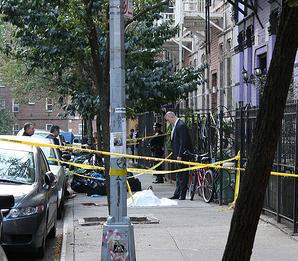The Christopher Jusko Murder and the Campaign Against Photographs of Dead Bodies

Recently a news organization published a photograph of a rather recently dead body. The former person in question photographed had been murdered and presumably the news outfit felt that a murder on its local turf had some news value. The victim’s family and friends were about ten kinds of furious. Meanwhile, written coverage of the murder and its circumstances was vigorous and regular on a number of New York City-based websites, including Gothamist and the Times, in large part because it took place in the East Village. Year-to-date, there have been four murders in the East Village’s Ninth Precinct, though I couldn’t tell you what the other three were. It’s reasonable that this is an item of news. The other publications’ stories include neighbors bad-mouthing the victim and their accounts of seeing the body and also praise for the character of the alleged killer. But it’s the picture that’s enraged people and sent the family’s friends and social networks into a campaign of furious mail. Eventually, the publication apparently reasoned it just wasn’t worth the harassment and they took down the photo.
“Someone with absolutely no conscience snapped a cell phone pic of his body before the police arrived and sent it to GAWKER.com who published it, unlike every reputable news site that ran photos of the covered body,” the victim’s uncle wrote. He wanted people to write the editor a letter — “to write this arrogant little shit a note,” is how he put it.
And then later:
It’s is a sad reality that we needed to mount such an effort and bring the Hammer of God down on them to rectify something that should never have been an issue in the first place. Don’t be fooled by the seemingly altruistic post on the GAWKER site concerning the photo’s removal. Remy Stern was adamant in his refusal to remove the picture before last night. The credit for it’s removal lies solely at the feet of all of you who took the time to voice your disgust and revulsion at such irresponsible yellow journalism in it’s worst incarnation.
There was a lesson. “Apparently when enough voices are raised in opposition to something so immoral the offenders have no option but to concede.”
That might be true but it’s also true in this world that when a group of people send a stream of invective-filled emails, sooner or later, one does tend to not want to deal with it. When the victim’s uncle wrote “Hammer of God,” he’s not really kidding. The emails were pretty intense!
The family — if not their random social network acquaintances — are, I think, entitled to behave pretty much as they wish at such a time. If they want to spend the days after a tragedy writing blistering emails to the media about a photograph, that’s a far better channeling of rage than hunting down the alleged killer’s family for retribution. And if you put yourself in their shoes, I bet any coverage of the murder at all feels invasive — at best.
And still it all keeps coming back to the body. “Every reputable news site… ran photos of the covered body,” he wrote. So that’s okay. It’s the idea of “disrespect” to the body that rankled. For those of us who aren’t Christian or religious at all, this idea can seem so odd — as weird as the (expressed) rationale for the Bush administration banning photographs of war dead (photographs which surely do have decided news value — less true in this case) or as weird as the idea of heaven.
The one media critic to address this came to a conclusion. “Having to speak with, say, the friends of a murdered man — as the Times did in its Jusko coverage — will make a journalist think twice about publishing a photo of the man’s bloody corpse…. Gawker probably believes its lack of engagement with its subjects makes it more independent — more free to report the actual truth, that is, rather than a truth mitigated by emotional considerations. In reality, this disconnect simply allows the site to be more callous in its coverage.”
This certainly reaffirms the idea of publishing photos of dead bodies as an explicit insult, a “callous” one, one made from a distance. If we knew the body, or if we knew the people who knew the body, this reasoning goes, we wouldn’t dare publish photos of it. Because to do so can only, apparently, be evil.
